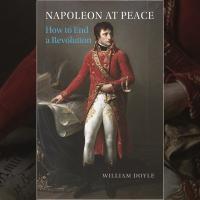There are libraries full of books on the French Revolution, on Napoleon, and on the Napoleonic Wars. It might seem unnecessary, then, to publish yet another book on the same subject, even one written by such a renowned expert as William Doyle. However, Napoleon at Peace fits nicely into the tiny niche still available for originality. For the central aim of this new book is to explain the processes and thinking of the first consul between his seizure of power in 1799 and the establishment of a European-wide peace in 1802.
It might be surprising that this particular aspect has been overlooked. After all, the establishment of power by dictators and monarchs has occupied reams of pages for other centuries and other people. And what Napoleon achieved in three short years, after a decade of chaos and revolution, is nothing short of extraordinary. Yet a brief glance through any university library catalogue confirms this to be the case. Then again, maybe it isn't so surprising: the violence and wars either side of this short period are bound to attract attention – it is history's version of rubbernecking. Furthermore, outside of France, at least, history has tended to focus on the victors' stories and their finally packing Napoleon off to St Helena after Waterloo. This is all exciting, self-affirming stuff. Why, then, should we consider a time when Napoleon was not really engaged in his favourite pastime of waging war?
The answer is simple: because not only is it interesting for its own sake, but because it also tells us something new about the first consul. There is no doubt that Napoleon loved war, and was, if not a great general, then at least a great leader of people. But he could also override his inclinations and think strategically and politically, putting peace ahead of conflict, and achieving remarkable feats as a result.
This is where Doyle's book comes in. Breaking the process down into thematic portions, he analyses the various aspects of rule to explain how Napoleon established peace across his war-torn country and beyond. In each chapter – covering the Brumaire coup, international relations, religion, and internal administration and control – Doyle introduces the problems arising from the Revolution and the steps Napoleon took to curb dissent, establish peace, and promote stability. In so doing, he explores Napoleon's own background and attitudes but never strays into the cluttered realms of full-blown biography.
This approach necessarily leads to some amount of repetition, which can become tiresome to someone reading the book from cover to cover in a few sittings. But it is difficult to see how Doyle can achieve his aims otherwise. Events and people inevitably overlap across the chapters, as they do in real life. Yet they remain fresh because they are witnessed from different perspectives, with different priorities in mind. So instead, each chapter should be read almost as its own essay, and when viewed as stand-alone pieces – similar to those one would find in an edited volume – it is easy to see how Napoleon at Peace would be extremely useful for students looking at specific aspects of the Revolution and of the first consul. But not only this: the multi-faceted, many-coloured method reveals a fuller, clearer view when the reader steps back to consider the book as a single entity. The narrative is strong enough to bring the different threads together; the analysis and sheer experience of the author convincing enough to endow this book with more substance than its relatively short length suggests. By necessity, the most beautiful of tapestries are woven, their different strands overlapping again and again to form a perfect picture. This is the approach Doyle has taken, and it has worked to produce a detailed, complex, and original picture providing new insight into a time and a man we all thought we knew well.


